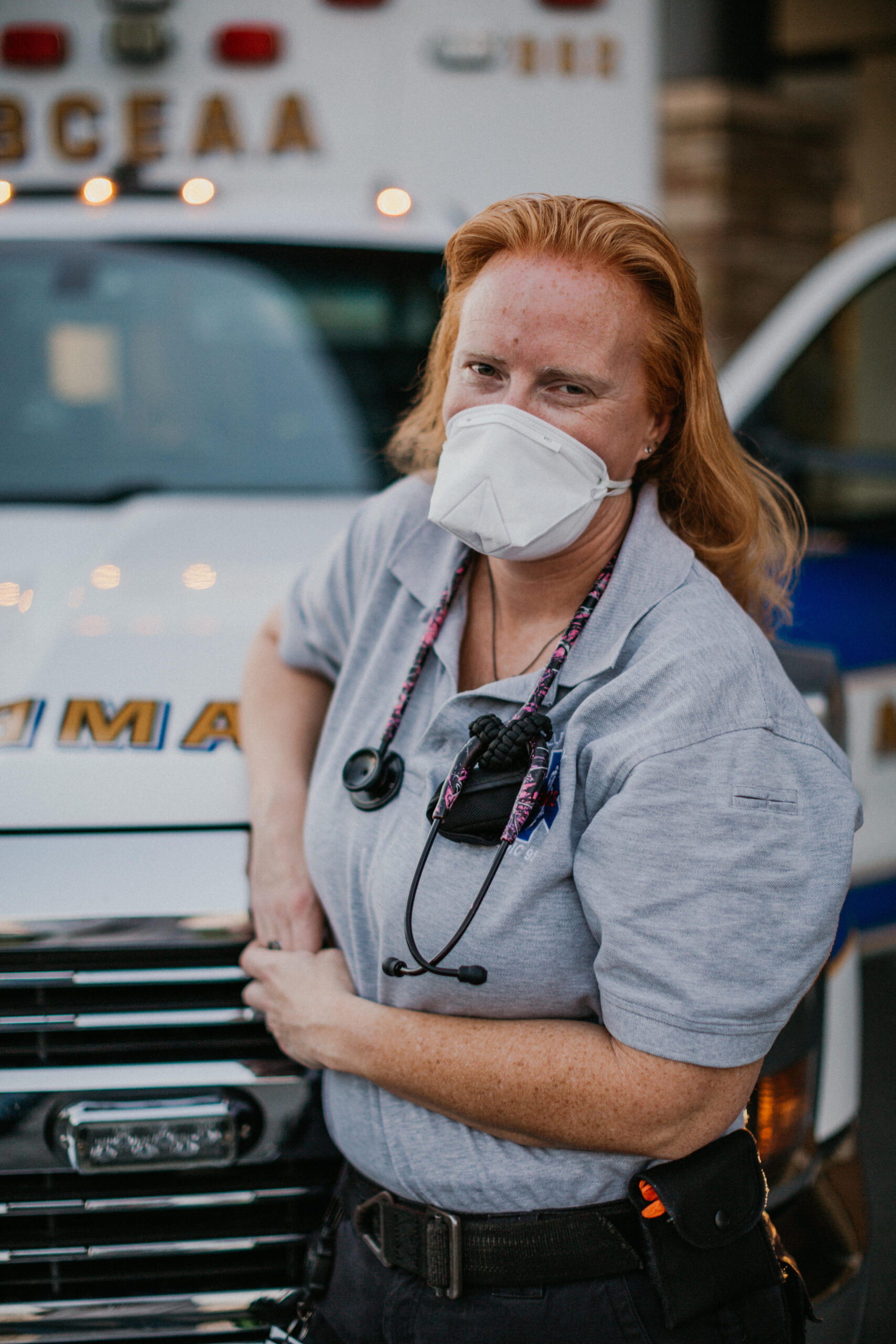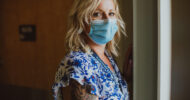
The service entrance doors slid to the right and, as Molly Humphreys and I exited the Berkeley Medical Center, we stepped into an unseasonably warm evening. “It’s the golden hour,” Molly said as we surveyed our surroundings and removed our masks, exposing flat faces with creased noses. Behind us stood a cold, somber hospital and we were engulfed in an empty parking lot, one flooded with radiant sunlight. My sense of time had been so warped by the COVID-19 pandemic that I had forgotten the date, Friday, November 6, 2020. We had been conducting interviews for Healthcare is Human and, after a few hours of this emotionally laborious project, we needed fresh air. I inhaled deeply and, before I realized what was happening, two women were sizing us up, wondering why we had emerged from the back of the hospital, one of us holding a microphone, the other with a camera. Angel Poe and her EMS partner had just delivered a patient to the ER and were leaning against the hood of their ambulance as it sparkled in the sun. We started a conversation and, in the moments that followed, Humphreys took a candid photo of Angel, an image that continues to work on me. I glanced over to see that, across Interstate 81, the sun had dropped behind North Mountain. The helipad on the hilltop glowed like a firefly as I turned my gaze southward into the silent Shenandoah Valley. As the camera clicked, I rubbed my nose and wondered what this photo would look like.
In the resulting image, Angel stares directly into Humphreys’ lens and a waterfall of rusty hair streams down her back, which Humphreys pops against her mask and the ambulance’s brilliant white hood. Her expression is not at all clear, but she projects wisdom and, while her eyes are compassionate, a world-weariness cannot be unseen. Humphreys’ portrait has, since 2020, posed so many questions, most of which I cannot answer. I find myself wondering what, exactly, EMS workers see as they work night and day in Berkeley County, West Virginia. And despite being an internal medicine doctor in Martinsburg, WV, for twenty years, I bet I don’t even know half of it.
Last year, there were 15,795 EMS calls in Berkeley County, with the Berkeley County Emergency Ambulance Authority servicing 321 square miles, a territory the size of New York City. For 9,100 of these calls, the patients were so sick that they were transported directedly to the hospital. The Berkeley Medical Center, located along Interstate 81, is home to the busiest emergency room in West Virginia with 55,000 visits in 2024. A truly democratic enterprise, 911 doesn’t, actually, care who you are. When they answer the phone, their response is “911, what’s your emergency?” This speaks volumes about their commitment to the work, the danger, and the need. Locally, nine crews work daily with over one hundred field staff. A remarkable public service, 911 is something that most of us take for granted. That is, until we need it immediately.
Sixty-three percent of local EMS transports last year involved advanced life support services, with an average response less than eight minutes, delivering 3,323 people to our local emergency department with chest pain, and 2,603 for vomiting and abdominal pain. These illnesses and injuries are, in a very practical way, pedestrian events for field clinicians like Angel. And yet, I have to wonder if they ever become “normal”? Is that even possible? Can you imagine performing a job where you routinely encounter dead people? Last year, 187 people were pronounced dead on arrival by our local EMS. When that happened, eyes like Angel’s attempted to comfort the living, those poor souls who were rendered into spasms beside their loved ones who were limp and lifeless in the driveway. Some had bled to death inside their crashed car along the roadside. Others had been shot in a parking lot by someone with a handgun. And too many had overdosed on a living room couch, the TV still flickering. West Virginia’s chronic illnesses and acute tragedies frequently share a common shrieking 911 phone call. EMS workers’ eyes absorb all of these images and their bodies swallow this pain.
How many of our neighbors have looked into these eyes for answers about what just happened, and why? Despite a workday that features a parade of illness, injury and pain, in this Humphreys photo we find the most feminine portrayal of physical strength. We regard a woman who is dressed to drive a truck and physically lift patients into her ambulance, all while she administers medication and communicates with the hospital. This lifting, pushing, pulling, driving, and loading is done by women in health care everyday, yet this labor is often buried behind the “expected” work of caregiving, such as nursing, social work, and the like. Ask a child to draw a woman in a hospital and you are likely to get a crayon drawing of a smiling nurse. The media often portrays women as the providers of Kleenex and hugs in health care with dramatically less emphasis on the women who contort their bodies to stabilize burn victims in the field as traffic whizzes by at eighty miles per hour.
A large print of this Humphreys’ photograph hangs on my office wall, one of the “Mona Lisa” portraits of Healthcare is Human. It has become a touchstone for many of my thoughts and feelings about emergency medical services, something I think about often. I’m grateful for those amongst us who race to the scene, “run to the fire,” as we say in West Virginia. They know that something tragic is likely waiting for them when they arrive. Molly Humphreys helps me see these individuals in a radiant new light. Or, maybe, to see them for the very first time. Either way, while I have seen their eyes, I struggle to know what they actually see.
This is the second article in a series about Molly Humphreys and her impact on healthcare as the principal photographer for Healthcare is Human, a storytelling project based in Martinsburg, WV. Healthcare is Human can be found on social media and Humphreys’ commercial portfolio by searching for Piccadilly Posh Photography.
Ryan McCarthy is an internal medicine physician.























![New data reveals the massive pay gap for women ER doctors [PODCAST]](https://kevinmd.com/wp-content/uploads/Design-4-190x100.jpg)
